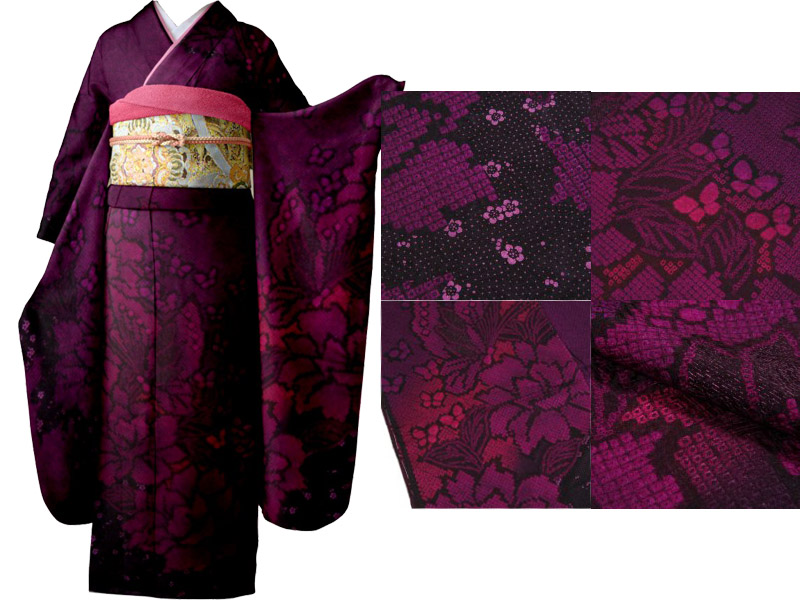和服漫談
The kimono is a Japanese traditional garment worn by women, men and children. The word “kimono”which literally means a “thing to wear” (ki "wear and mono “thing”),has come to denote these full-length robes. Kimonos made with exceptional skill from fine materials have been regarded as great works of art.
和服是日本男女老少所穿著的傳統服裝。“和服”字面上的意思 是“穿的東西”(ki是“穿”,mono是“東西”),用來表述這種長袍。材料精美、做功精細的和服被視為藝術品
Today, kimonos are most often worn by women, and on special occasions. Traditionally, unmarried women wore a style of kimono called furisode, with almost floor-length sleeves, on special occasions. A few older women and even fewer men still wear the kimono on a daily basis. Men wear the kimono most often at weddings, tea ceremonies, and other very special or very formal occasions. Professional sumo wrestlers are often seen in the kimono because they are required to wear traditional Japanese dress whenever appearing in public.
如今,和服大多是女性在特殊場合里才會穿的服裝。傳統上,未婚女性在特殊場合穿著稱為振袖的和服,這種和服有著幾乎及地的長袖。一些老年婦女,甚至為數更少的男子仍然每天穿著和服。男子大多在婚禮、茶道和其他非常特殊或非常正式的場合才穿和服。我們經常看到職業相撲選手穿和服,那是因為他們被要求在公共場合出現時必須穿著日本傳統服裝。
As the kimono has another name gofuku, the earliest kimonos were heavily influenced by traditional Han Chinese clothing, known today as faanfu, through Japanese embassies to China which resulted in extensive Chinese culture adoptions by Japan, as early as the fifth century. It was during the 8th century, however, when Chinese fashions eame into style among the Japanese, and Ae overlapping collar became particularfy a women、fashion. During Japan's Heian period (794—1192), the kimono became increasingly stylized, though one still wore a half-apron, called a mo, over it. During the Muromachi age (1392_1573), the Kosade, a single kimono formerly considered underwear, began to be worn without the hakama pants over it, and thus began to be held closed by an obi “belt”. During the Edo period (1603—1867), the sleeves began to grow in length, especially among unmarried women, and the Obi became wider, with various styles of tying coming into fashion. Since then, the basic shape of both the men’s and women’s kimono has remained essentially unchanged.
從和服的別名吳服可知,早期和服深受傳統漢族服裝(即今天的漢服)的影響。早在5世紀,日本就開始大量吸收這種由遣唐使者帶回的中國文化。然而,這種中國服裝在8世紀才開始在日本流行起來,尤其是交領成為婦女的時尚。在日本平安時代(794-1192年〉,和服日益形成自己的風格,但仍有一個稱為裳的半裙。在室町時代 (1392-1573年),人們開始穿過去被當成襯衣的小袖,不再在其外面穿和服裙褲,而開始改用寬腰帶來束縛。在江戶時代(1603-1867 年),袖子變得更長(特別是未婚婦女),腰帶變得更寬,各種系法變成了時尚。自那時起,男式和女式和服的樣式基本定型。
The formal Kimono was replaced by the more convenient Western clothes and Yukata as everyday wear. After an edict by Emperor Meiji, police, railroad men and teachers moved to Western clothes. The Western clothes became the anny and school uniform for boys. After the 1923 Great Kanto earthquake, Kimono wearers often became victims of robbery. The Tokyo Women’s & Children’s Wear Manufacturers' Association promoted the western clothes. Between 1920 and 1930 the Sailor outfit replaced the undivided hakama in school uniform for girls. The 1932 fire at Shirokiya’s Nihombashi store is said to have been the catalyst for the decline in kimonos as everyday wear. The national uniform, Gokumin-fuku, a type of western clothes was mandated for males in 1940. Today people often wear western clothes, and wear the easier to wear, cool and comfortable Yukata in special time.

正式的和服作為日常穿著的地位,被更為便捷的西服和浴衣所取代。在明治天皇頒布一項法令后,警察、鐵路工人和教師開始改穿西服。西服成為軍隊和學校男子的制服。在1923年的關東大地震后,穿著和服的人往往成為被搶劫的對象。東京婦女和兒童服裝制造商協會推動了西服的普及。1920到1930年間,水手服取代不可分割的和服裙褲,成為女生的校服。1932年,Shirokiya的 Nihombashi店的火災被認為是造成和服在日常生活中的使用下降的催化劑。1940年,男子被要求穿全國性的制服國民服,這是西服的一種。今天,人們通常穿西服,在特殊場合穿更容易穿著更涼爽和舒適的浴衣。
A woman’s kimono may easily exceed US$ 10,000; a complete kimono outfit, with kimono, undergarments, obi, ties, socks, sandals and accessories, can exceed US$ 20,000. A single obi may cost several thousand dollars. However, most kimonos owned by kimono hobbyists or by practitioners of traditional arts are far less expensive. Enterprising people make their own kimono and undergarments by following a standard pattern, or by recycling older kimonos. Cheaper and machine-made fabrics can substitute for the traditional hand-dyed silk. There is also a thriving business in Japan for secondhand kimonos, which can cost as little as ¥ 500. Women's obis, however, mostly remain an expensive item. Although simple patterned or plain colored ones can cost as little as ¥ 1,500, even a used obi can cost hundreds of dollars, and experienced craftsmanship is required to make them. Men’s obis, even those made from silk, tend to be much less expensive, because they are narrower, shorter and less decorative than those worn by women.
女式和服的價格超過1萬美元很正常,一套完整的和服包括和服、襯衣、寬腰帶、帶子、襪子、木屐和其他裝飾品,價格可超過2萬美元。光一個寬腰帶都要好幾千美元。然而,大多數和服愛好者或者傳統藝術工作者所擁有的和服遠沒有那么貴。有創業精神的人自己按標準模板或通過回收利用舊和服來制作和服和襯衣。相對更便宜的機器制造面料可以替代傳統的手工印染絲綢。日本還有繁榮的二手和服業,一套和服可低至500人民幣。然而,女性的寬腰帶大多數還是很昂貴。雖然圖案簡單或純色的和服可低至1500人民幣,但即使是一條二手寬腰帶都要幾百美元,而且需要有經驗的師傅來制作。然而,男子的寬腰帶即使是絲綢做的也遠沒那么貴,因為他們比女式的更窄、更短、裝飾更少。












